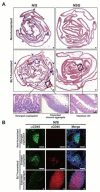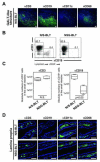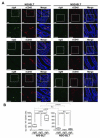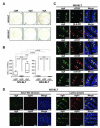Cryptopatches are essential for the development of human GALT
- PMID: 23791525
- PMCID: PMC3725137
- DOI: 10.1016/j.celrep.2013.05.037
Cryptopatches are essential for the development of human GALT
Abstract
Abnormal gut-associated lymphoid tissue (GALT) in humans is associated with infectious and autoimmune diseases, which cause dysfunction of the gastrointestinal (GI) tract immune system. To aid in investigating GALT pathologies in vivo, we bioengineered a human-mouse chimeric model characterized by the development of human GALT structures originating in mouse cryptopatches. This observation expands our mechanistic understanding of the role of cryptopatches in human GALT genesis and emphasizes the evolutionary conservation of this developmental process. Immunoglobulin class switching to IgA occurs in these GALT structures, leading to numerous human IgA-producing plasma cells throughout the intestinal lamina propria. CD4+ T cell depletion within GALT structures results from HIV infection, as it does in humans. This human-mouse chimeric model represents the most comprehensive experimental platform currently available for the study and for the preclinical testing of therapeutics designed to repair disease-damaged GALT.
Copyright © 2013 The Authors. Published by Elsevier Inc. All rights reserved.
Figures





References
-
- Brenchley JM, Price DA, Schacker TW, Asher TE, Silvestri G, Rao S, Kazzaz Z, Bornstein E, Lambotte O, Altmann D, et al. Microbial translocation is a cause of systemic immune activation in chronic HIV infection. Nat. Med. 2006;12:1365–1371. - PubMed
-
- Cao X, Shores EW, Hu-Li J, Anver MR, Kelsall BL, Russell SM, Drago J, Noguchi M, Grinberg A, Bloom ET, et al. Defective lymphoid development in mice lacking expression of the common cytokine receptor γ chain. Immunity. 1995;2:223–238. - PubMed
Publication types
MeSH terms
Grants and funding
LinkOut - more resources
Full Text Sources
Other Literature Sources
Research Materials
Miscellaneous

